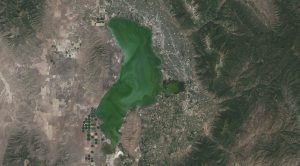 Come summer, Utahns will flock to the state's lakes and reservoirs to boat, swim and picnic along the shore. And every week, if not every day, scientists such as Kate Fickas of Utah State University in Logan will use satellite images and other data to monitor recreation sites to check for rapid growth of algae into a bloom, and make sure the water is safe for people and pets.
Come summer, Utahns will flock to the state's lakes and reservoirs to boat, swim and picnic along the shore. And every week, if not every day, scientists such as Kate Fickas of Utah State University in Logan will use satellite images and other data to monitor recreation sites to check for rapid growth of algae into a bloom, and make sure the water is safe for people and pets.
From the vantage point of space, satellites, including the NASA and U.S. Geological Survey's (USGS) Landsat 8, can help scientists identify lakes where a bloom has formed. It's a complicated data analysis process, but one that researchers are automating to assist resource managers in identifying potential problems.
Blooms are made up of naturally occurring algae, phytoplankton, and cyanobacteria that explode in number under the right conditions: warm temperatures, lots of nutrients and calm waters. Many water bodies in Utah meet those conditions, Fickas said, especially with warming temperatures due to climate change as well as nutrient-rich runoff from agricultural fields and other sources.
Satellites including Landsat 8 and ESA's Sentinel-3 can detect when a lake changes color due to the mats of greenish organisms, allowing scientists like Fickas to tell water managers where to test to see if the waters are harmful or not. The two satellites have different strengths: Sentinel-3 collects data on individual lakes more frequently and measures wavelengths of light that are more indicative of phytoplankton, but Landsat 8 has a higher spatial resolution, so it can observe smaller lakes and identify specific problem areas within a larger lake.
Landsat satellite-based detection of a 2017 bloom in Lake Utah (pictured) helped save an estimated $370,000 in healthcare and related costs for the area, according to a 2020 study published in the journal GeoHealth. The case study builds on a larger multi-agency project to track algal blooms.
Image Credit: NASA/USGS

